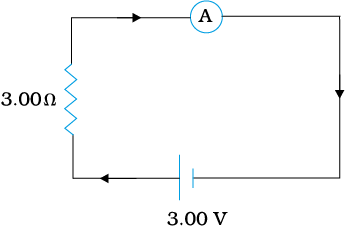A \(100\) turn closely wound circular coil of radius \(10~\text{cm}\) carries a current of \(3.2~\text{A}.\) The magnetic moment of this coil is:
1. \(20~\text{A-m}^2\)
2. \(10~\text{A-m}^2\)
3. \(30~\text{A-m}^2\)
4. \(15~\text{A-m}^2\)
1. \(20~\text{A-m}^2\)
2. \(10~\text{A-m}^2\)
3. \(30~\text{A-m}^2\)
4. \(15~\text{A-m}^2\)
A 100 turn closely wound circular coil of radius 10 cm carries a current of 3.2 A. The coil is placed in a vertical plane and is free to rotate about a horizontal axis that coincides with its diameter. A uniform magnetic field of 2T in the horizontal direction exists such that initially, the axis of the coil is in the direction of the field. The coil rotates through an angle of 90° under the influence of the magnetic field. What is the difference of magnitude of the torque on the coil in the initial and final position?
A 100 turn closely wound circular coil of radius 10 cm carries a current of 3.2 A. What is the angular speed acquired by the coil when it has rotated by 90° under the influence of a magnetic field of magnitude 2T that is applied along the axis of the coil? The moment of inertia of the coil is 0.1 kg-.
Which one of the following statements is incorrect?
| 1. | A current-carrying circular loop lies on a smooth horizontal plane. A uniform magnetic field can be set up in such a manner that the loop turns around itself (i.e., turns about the vertical axis). |
| 2. | A current-carrying circular loop is located in a uniform external magnetic field. If the loop is free to turn, the orientation of stable equilibrium is one where the area vector A of the loop is in the direction of the external magnetic field. |
| 3. | A loop of irregular shape carrying current is located in an external magnetic field. If the wire is flexible, it changes to a circular shape. |
| 4. | None of these. |
For the circuit (shown in the figure), the current is to be measured. The ammeter shown is a galvanometer with a resistance . The value of current is:

1. 0.004 A
2. 0.032 A
3. 0.222 A
4. 0.048 A
In the circuit (shown in the figure) the current is to be measured. What is the value of the current if the ammeter shown is a galvanometer but converted to an ammeter by a shunt resistance ?

A solenoid has a core of material with relative permeability \(400.\) The windings of the solenoid are insulated from the core and carry a current of \(2~\text{A}.\) If the number of turns is \(1000\) per metre, the magnetizing current \(I_m\) is:
1. \(746~\text{A}\)
2. \(700~\text{A}\)
3. \(729~\text{A}\)
4. \(794~\text{A}\)
The SI unit of magnetic field intensity is
1.
2.
3.
4.
A thick current-carrying cable of radius '\(R\)' carries current \('I'\) uniformly distributed across its cross-section. The variation of magnetic field \(B(r)\) due to the cable with the distance '\(r\)' from the axis of the cable is represented by:
| 1. |  |
2. |  |
| 3. |  |
4. |  |
An infinitely long straight conductor carries a current of \(5~\text{A}\) as shown. An electron is moving with a speed of \(10^5~\text{m/s}\) parallel to the conductor. The perpendicular distance between the electron and the conductor is \(20~\text{cm}\) at an instant. Calculate the magnitude of the force experienced by the electron at that instant.
1. \(4\pi\times 10^{-20}~\text{N}\)
2. \(8\times 10^{-20}~\text{N}\)
3. \(4\times 10^{-20}~\text{N}\)
4. \(8\pi\times 10^{-20}~\text{N}\)







